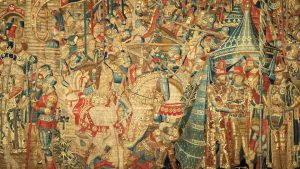One of the most expensive and time-consuming crafts, dynamic and expressive in skilled hands, Tapestry has always been highly prized and central to the regalia of prestige and power. The technology of weaving a tapestry is very simple, yet the great variety of expressive qualities inherent in handwoven Tapestry makes it an expertise of intricacies and complexities.
Traditionally Tapestry is a form of textile art, woven by hand on a loom. Broadly the name has been used for almost any heavy material, handwoven, machine woven or even embroidered, used to cover furniture, walls or floors or for the decoration of clothing.

The iconography of most Western tapestries goes back to written sources, the Bible and Ovid’s Metamorphoses being two popular choices. Apart from the religious and mythological images, hunting scenes are the subject of many tapestries produced for indoor decoration. Kings and noblemen could roll up and transport tapestries from one residence to another. In churches, they were displayed on special occasions. Tapestries were also draped on the walls of castles for insulation during winter, as well as for decorative display.
In European medieval and Renaissance practice, the design of Tapestry was invariably copied from a full-scale colored pattern, known as Cartoon, a practice that continues to this day. The quality of Tapestry depends mainly on four variable factors: the quality of the cartoon from which it is copied, the skill of the weavers at translating the design into woven form, the fitness of the weave and the quality of the materials from which it is made.

Wool has been the material most widely used for making the warp, or the parallel sides of threads that run lengthwise in the fabric of the Tapestry. The advantage of wool in the weaving of Tapestries has been its availability, workability, durability and the fact that it can be easily dyed to obtain a wide range of colours. Wool has often been used in combination with Linen, Silk or Cotton threads for the weft.
LIST OF FAMOUS TAPESTRIES:
A) The Trojan War Tapestry
B) The Cloth of St.Gereon
C) Sampul Tapestry
D) The Hestia Tapestry
E) The Quaker Tapestry




